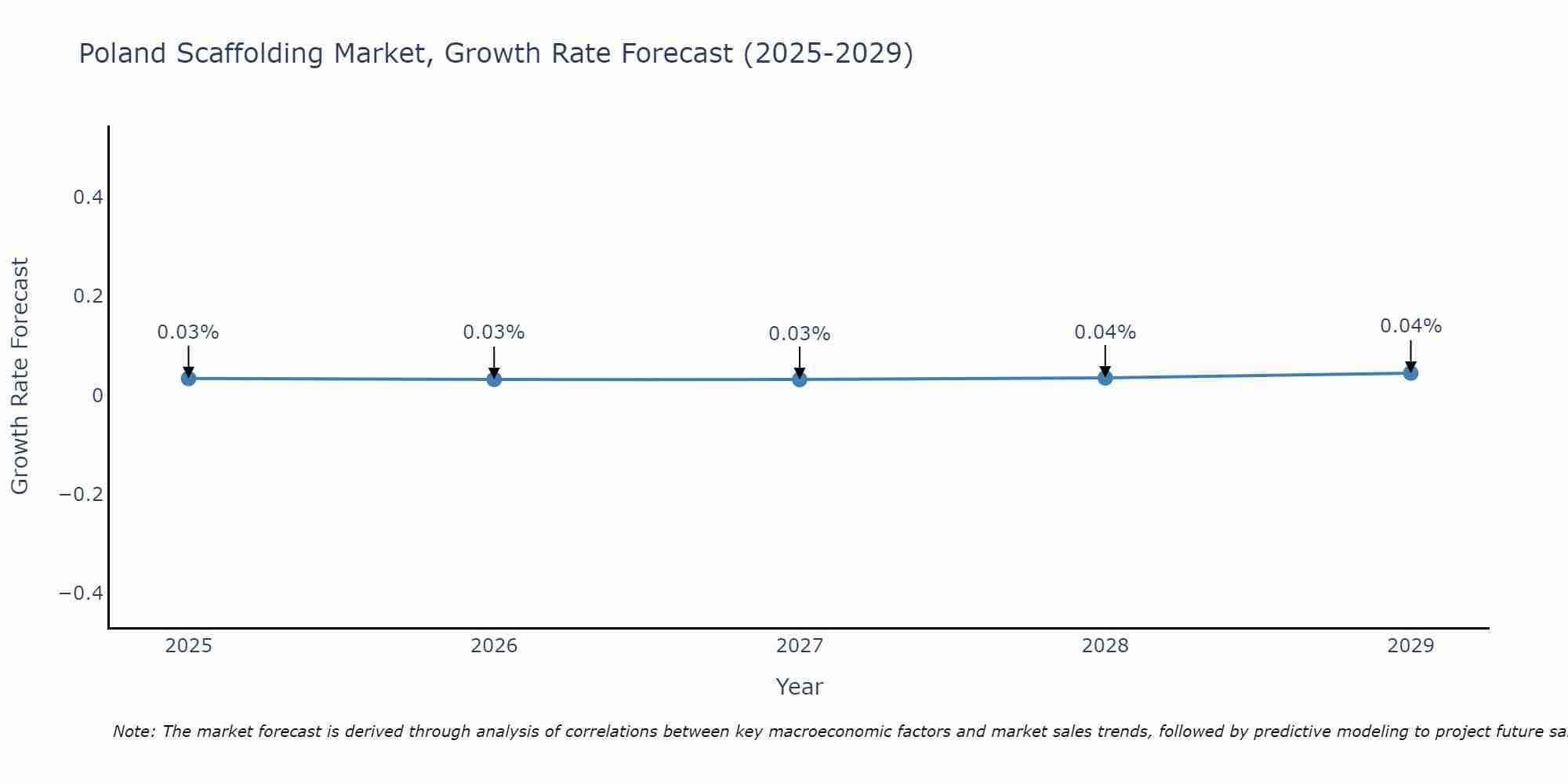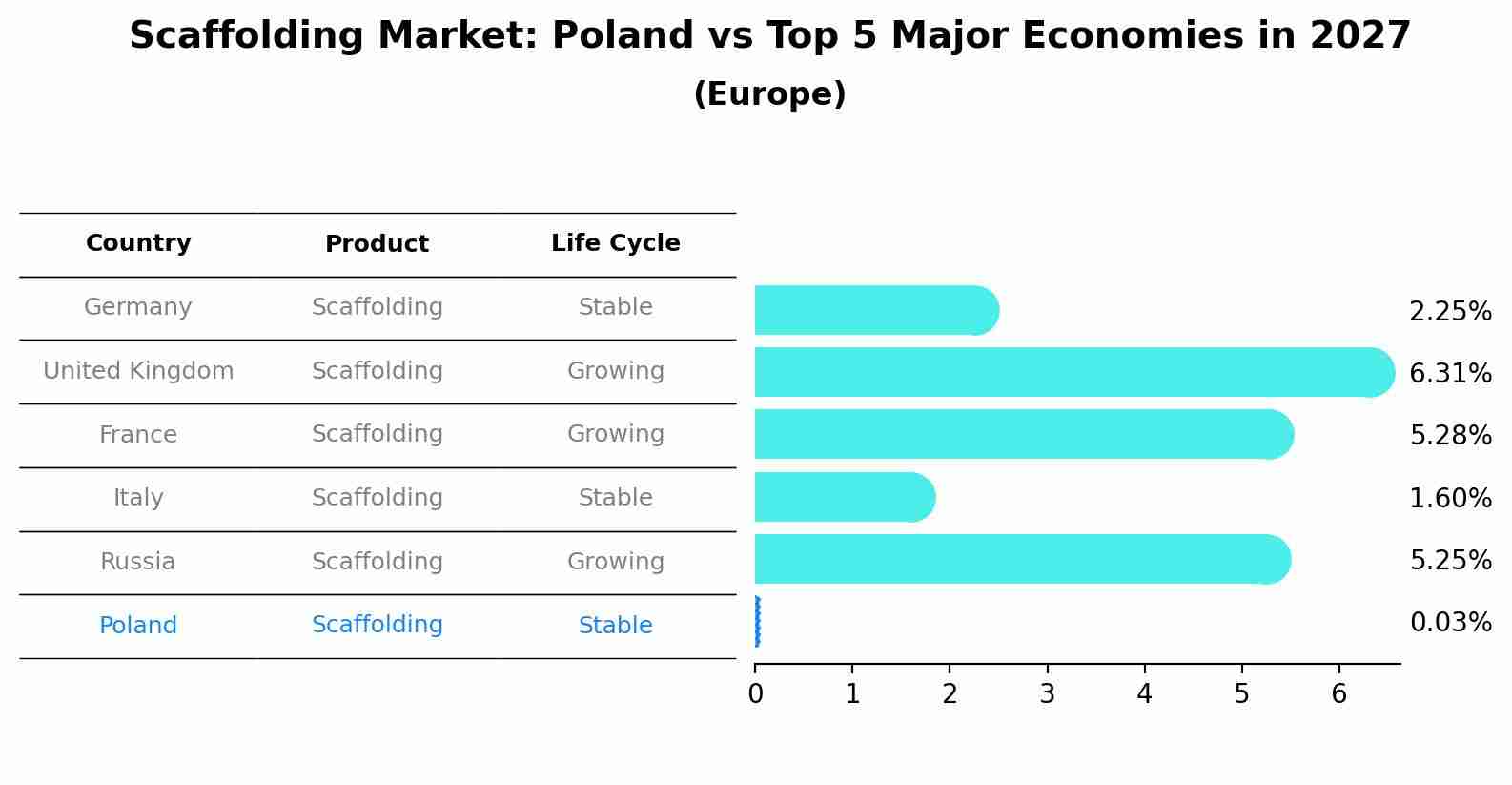Poland Scaffolding Market Outlook | Trends, Value, Analysis, Share, Revenue, Industry, Size, COVID-19 IMPACT, Companies, Growth & Forecast
| Product Code: ETC377775 | Publication Date: Aug 2022 | Updated Date: Jul 2025 | Product Type: Market Research Report | |
| Publisher: 6Wresearch | Author: Dhaval Chaurasia | No. of Pages: 75 | No. of Figures: 35 | No. of Tables: 20 |
Poland Scaffolding Market Size Growth Rate
The Poland Scaffolding Market is projected to witness mixed growth rate patterns during 2025 to 2029. From 0.03% in 2025, the growth rate steadily ascends to 0.04% in 2029.

Scaffolding Market: Poland vs Top 5 Major Economies in 2027 (Europe)
In the Europe region, the Scaffolding market in Poland is projected to expand at a stable growth rate of 0.03% by 2027. The largest economy is Germany, followed by United Kingdom, France, Italy and Russia.

Poland Scaffolding Market Synopsis
The Poland scaffolding market is experiencing steady growth driven by increasing construction activities in the country. The market is characterized by a wide range of scaffolding products including steel, aluminum, and fiberglass, catering to the diverse needs of the construction industry. Factors such as the government`s investments in infrastructure development, growing urbanization, and renovation projects are fueling the demand for scaffolding solutions. Key players in the market are focusing on product innovations, safety features, and rental services to gain a competitive edge. Additionally, stringent regulations regarding worker safety and the emphasis on quality construction practices are influencing the market dynamics. Overall, the Poland scaffolding market is expected to continue its growth trajectory in the coming years due to the robust construction sector in the country.
Poland Scaffolding Market Trends
The Poland scaffolding market is currently experiencing a steady growth due to increasing construction activities in both residential and commercial sectors. The market is witnessing a rising demand for advanced scaffolding systems that offer enhanced safety features and efficiency. Aluminum scaffolding is gaining popularity for its lightweight and durable properties, while modular scaffolding systems are being favored for their ease of assembly and versatility. Additionally, there is a growing emphasis on eco-friendly scaffolding materials to align with sustainable construction practices. Market players are focusing on innovation and technological advancements to meet the evolving demands of the construction industry in Poland, driving the overall growth and development of the scaffolding market.
Poland Scaffolding Market Challenges
In the Poland scaffolding market, some challenges include intense competition among market players leading to price wars and margin pressures. Additionally, ensuring compliance with stringent safety regulations and standards poses a challenge for scaffolding companies operating in the country. Economic fluctuations and uncertainties can also impact construction activities, thereby affecting the demand for scaffolding services. Rising material costs and labor shortages further add to the challenges in the Poland scaffolding market. Companies need to constantly innovate and invest in technology to stay competitive while maintaining high safety standards and complying with regulations to overcome these challenges and succeed in the market.
Poland Scaffolding Market Investment Opportunities
The Poland scaffolding market presents promising investment opportunities due to the country`s ongoing infrastructure development and construction activities. With a growing demand for residential, commercial, and industrial projects, the need for scaffolding solutions is expected to rise. Investors can consider opportunities in supplying scaffolding equipment, rental services, and innovative solutions to cater to the market`s evolving needs. Additionally, the adoption of advanced technologies such as digital platforms for scaffolding management and safety solutions presents avenues for investment in the sector. Collaborating with local construction companies and staying updated on regulatory requirements and industry trends can help investors capitalize on the growth potential of the Poland scaffolding market.
Jordan Agar Market Government Policies
In Poland, the scaffolding market is regulated by various government policies aimed at ensuring safety and quality standards. The main regulations governing the industry include the Construction Law, which outlines requirements for the design, installation, and use of scaffolding structures to prevent accidents and ensure worker safety. Additionally, the Labor Code sets out guidelines for employers to provide a safe working environment for employees using scaffolding equipment. The Polish Construction Technology Assessment Institute (ITB) also plays a role in certifying scaffolding products and companies to ensure compliance with national and European standards. Overall, these government policies aim to promote best practices in the scaffolding industry and protect the well-being of workers and the public.
Poland Scaffolding Market Future Outlook
The Poland scaffolding market is expected to witness steady growth in the coming years, driven by ongoing infrastructure development projects, increasing construction activities, and the country`s booming real estate sector. The implementation of stringent safety regulations and growing awareness regarding the benefits of using scaffolding in construction projects will further boost market demand. Additionally, the adoption of advanced technologies such as digitalization, automation, and 3D printing in the construction industry is likely to create new opportunities for scaffolding manufacturers and suppliers. However, challenges such as fluctuating raw material prices and labor shortages may impact market growth. Overall, the outlook for the Poland scaffolding market remains positive, with a projected trajectory of sustained expansion in the foreseeable future.
Key Highlights of the Report:
- Poland Scaffolding Market Outlook
- Market Size of Poland Scaffolding Market, 2021
- Forecast of Poland Scaffolding Market, 2031
- Historical Data and Forecast of Poland Scaffolding Revenues & Volume for the Period 2018 - 2031
- Poland Scaffolding Market Trend Evolution
- Poland Scaffolding Market Drivers and Challenges
- Poland Scaffolding Price Trends
- Poland Scaffolding Porter's Five Forces
- Poland Scaffolding Industry Life Cycle
- Historical Data and Forecast of Poland Scaffolding Market Revenues & Volume By Type for the Period 2018 - 2031
- Historical Data and Forecast of Poland Scaffolding Market Revenues & Volume By Supported Scaffolding for the Period 2018 - 2031
- Historical Data and Forecast of Poland Scaffolding Market Revenues & Volume By Suspended Scaffolding for the Period 2018 - 2031
- Historical Data and Forecast of Poland Scaffolding Market Revenues & Volume By Rolling Scaffolding for the Period 2018 - 2031
- Historical Data and Forecast of Poland Scaffolding Market Revenues & Volume By Material for the Period 2018 - 2031
- Historical Data and Forecast of Poland Scaffolding Market Revenues & Volume By Aluminum for the Period 2018 - 2031
- Historical Data and Forecast of Poland Scaffolding Market Revenues & Volume By Wood for the Period 2018 - 2031
- Historical Data and Forecast of Poland Scaffolding Market Revenues & Volume By Steel for the Period 2018 - 2031
- Historical Data and Forecast of Poland Scaffolding Market Revenues & Volume By End User for the Period 2018 - 2031
- Historical Data and Forecast of Poland Scaffolding Market Revenues & Volume By Residential for the Period 2018 - 2031
- Historical Data and Forecast of Poland Scaffolding Market Revenues & Volume By Commercial for the Period 2018 - 2031
- Historical Data and Forecast of Poland Scaffolding Market Revenues & Volume By Industrial for the Period 2018 - 2031
- Poland Scaffolding Import Export Trade Statistics
- Market Opportunity Assessment By Type
- Market Opportunity Assessment By Material
- Market Opportunity Assessment By End User
- Poland Scaffolding Top Companies Market Share
- Poland Scaffolding Competitive Benchmarking By Technical and Operational Parameters
- Poland Scaffolding Company Profiles
- Poland Scaffolding Key Strategic Recommendations
Frequently Asked Questions About the Market Study (FAQs):
- Single User License$ 1,995
- Department License$ 2,400
- Site License$ 3,120
- Global License$ 3,795
Search
Related Reports
- ASEAN Bearings Market (2025-2031) | Strategy, Consumer Insights, Analysis, Investment Trends, Opportunities, Growth, Size, Share, Industry, Revenue, Segments, Value, Segmentation, Supply, Forecast, Restraints, Outlook, Competition, Drivers, Trends, Demand, Pricing Analysis, Competitive, Strategic Insights, Companies, Challenges
- Europe Flooring Market (2025-2031) | Outlook, Share, Industry, Trends, Forecast, Companies, Revenue, Size, Analysis, Growth & Value
- Saudi Arabia Manlift Market (2025-2031) | Outlook, Size, Growth, Trends, Companies, Industry, Revenue, Value, Share, Forecast & Analysis
- Uganda Excavator, Crane, and Wheel Loaders Market (2025-2031) | Strategy, Consumer Insights, Analysis, Investment Trends, Opportunities, Growth, Size, Share, Industry, Revenue, Segments, Value, Segmentation, Supply, Forecast, Restraints, Outlook, Competition, Drivers, Trends, Demand, Pricing Analysis, Competitive, Strategic Insights, Companies, Challenges
- Rwanda Excavator, Crane, and Wheel Loaders Market (2025-2031) | Strategy, Consumer Insights, Analysis, Investment Trends, Opportunities, Growth, Size, Share, Industry, Revenue, Segments, Value, Segmentation, Supply, Forecast, Restraints, Outlook, Competition, Drivers, Trends, Demand, Pricing Analysis, Competitive, Strategic Insights, Companies, Challenges
- Kenya Excavator, Crane, and Wheel Loaders Market (2025-2031) | Strategy, Consumer Insights, Analysis, Investment Trends, Opportunities, Growth, Size, Share, Industry, Revenue, Segments, Value, Segmentation, Supply, Forecast, Restraints, Outlook, Competition, Drivers, Trends, Demand, Pricing Analysis, Competitive, Strategic Insights, Companies, Challenges
- Angola Excavator, Crane, and Wheel Loaders Market (2025-2031) | Strategy, Consumer Insights, Analysis, Investment Trends, Opportunities, Growth, Size, Share, Industry, Revenue, Segments, Value, Segmentation, Supply, Forecast, Restraints, Outlook, Competition, Drivers, Trends, Demand, Pricing Analysis, Competitive, Strategic Insights, Companies, Challenges
- Israel Intelligent Transport System Market (2025-2031) | Strategy, Consumer Insights, Analysis, Investment Trends, Opportunities, Growth, Size, Share, Industry, Revenue, Segments, Value, Segmentation, Supply, Forecast, Restraints, Outlook, Competition, Drivers, Trends, Demand, Pricing Analysis, Competitive, Strategic Insights, Companies, Challenges
- Uganda Precast and Aggregate Market (2025-2031) | Strategy, Consumer Insights, Analysis, Investment Trends, Opportunities, Growth, Size, Share, Industry, Revenue, Segments, Value, Segmentation, Supply, Forecast, Restraints, Outlook, Competition, Drivers, Trends, Demand, Pricing Analysis, Competitive, Strategic Insights, Companies, Challenges
- Australia IT Asset Disposal Market (2025-2031) | Strategy, Consumer Insights, Analysis, Investment Trends, Opportunities, Growth, Size, Share, Industry, Revenue, Segments, Value, Segmentation, Supply, Forecast, Restraints, Outlook, Competition, Drivers, Trends, Demand, Pricing Analysis, Competitive, Strategic Insights, Companies, Challenges
Industry Events and Analyst Meet
Our Clients
Whitepaper
- Middle East & Africa Commercial Security Market Click here to view more.
- Middle East & Africa Fire Safety Systems & Equipment Market Click here to view more.
- GCC Drone Market Click here to view more.
- Middle East Lighting Fixture Market Click here to view more.
- GCC Physical & Perimeter Security Market Click here to view more.
6WResearch In News
- Doha a strategic location for EV manufacturing hub: IPA Qatar
- Demand for luxury TVs surging in the GCC, says Samsung
- Empowering Growth: The Thriving Journey of Bangladesh’s Cable Industry
- Demand for luxury TVs surging in the GCC, says Samsung
- Video call with a traditional healer? Once unthinkable, it’s now common in South Africa
- Intelligent Buildings To Smooth GCC’s Path To Net Zero













